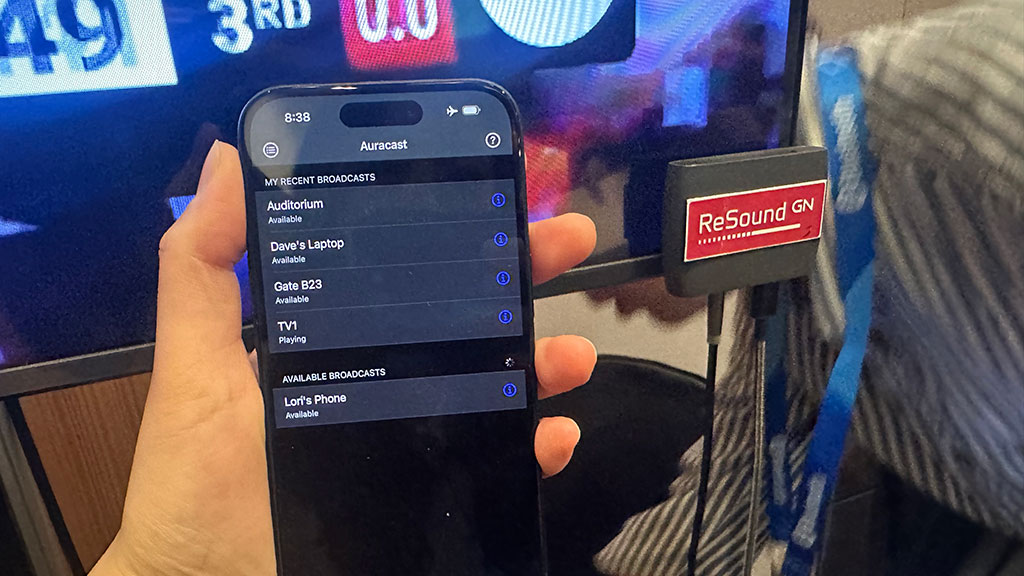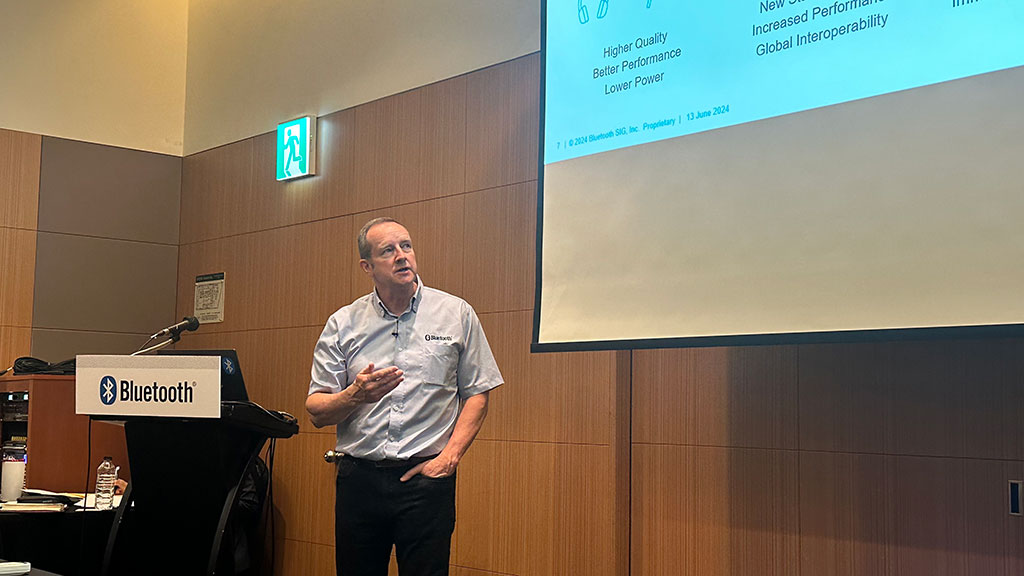블루투스 기술 표준 관리 및 감독하는 비영리 조직 블루투스 SIG(Special Interest Group)가 13일 코엑스 인터컨티넨탈에서 미디어 간담회를 열고 ‘오라캐스트(Auracast)™ 브로드캐스트’ 기술을 소개, 국내에서는 처음으로 시나리오를 시연했다.
▲블루투스 SIG 마켓 개발 부문 척 사빈(Chuck Sabin) 이사
블루투스 LE 오라캐스트™ 브로드캐스트 공개 시연
삼성·샤오미·퀄컴·미디어텍·구글·MS 등 생태계 확장
20년간 오디오 분야의 혁신을 주도해 온 블루투스 SIG가 LE 오디오 아키텍처를 기반으로 새로운 ‘오라캐스트™ 브로드캐스트’를 소개했다. 블루투스 SIG 마켓 개발 부문 척 사빈(Chuck Sabin) 이사는 “블루투스 오라캐스트™ 브로드캐스트 오디오는 소비자들에게 서로 연결된 세상에서 소통할 수 있는 새롭고 창의적인 방식을 제안하는 등 무선 오디오 시장의 또 다른 거대한 변화를 이끌 것”이라고 전했다.
블루투스
® 기술 표준 관리 및 감독하는 비영리 조직 블루투스 SIG(Special Interest Group)가 13일 코엑스 인터컨티넨탈에서 미디어 간담회를 열고 ‘오라캐스트(Auracast)™ 브로드캐스트’ 기술을 소개, 국내에서는 처음으로 시나리오를 시연했다.
높은 음질과 낮은 전력 소비를 위한 상호 운용성을 개선한 블루투스 LE(저에너지) 기반 LE 오디오는 2022년 표준화가 완료됐다. ‘오라캐스트™ 브로드캐스트’ 기술은 이를 기반으로, 기존의 오디오 페어링과 달리 스마트폰, 노트북, TV 또는 공용 방송 설비와 같은 오디오 디바이스에서 스피커, 이어폰을 비롯한 오디오 수신 디바이스의 수에 상관없이 무제한으로 오디오를 송출할 수 있는 기술이다.
오라캐스트™ 브로드캐스트 오디오는 특히 공공장소에서 새로운 오디오 경험을 보다 고품질로 제공한다는 장점을 갖는다. 이는 공개 및 비공개 송출을 설정할 수 있어 보안을 보장받을 수 있다.
예컨대 해당 기술을 사용하면 극장, 회의실, 공항이나 컨퍼런스룸과 같은 인구 밀집 지역에서 영상의 소리가 잘 들리지 않을 경우, 와이파이와 연결하듯 송신기와 수신 기기를 연결해 소리를 선명하게 들을 수 있게 된다. 이어폰 기기를 직접 공유하지 않아도 오디오를 핸드폰을 통해 공유하면 동일한 오디오를 함께 듣는 것이 가능해진다. 또한 블루투스 SIG는 “보청기 시스템 간의 접근성을 향상해 무선 오디오 디바이스와 보청기를 활용한 업계에 긍정적 변화를 가져올 것으로 기대된다”고 덧붙였다.
■ 삼성, 갤럭시 S24 등에 오라캐스트™ 브로드캐스트 기능 탑재
 ▲
▲오라캐스트™ 브로드캐스트 시연 모습
오라캐스트™ 브로드캐스트를 작동하기 위해 필요한 송신기는 텔레비전, 노트북, 태블릿, PA 시스템 등 오디오를 송출할 수 있으면 모두 사용 가능하다. 이는 보청기, 헤드폰 등 수신이 가능한 모든 디바이스와 연결될 수 있다. 보조기는 양 기기를 연결하는 역할로, 스마트폰, 스마트워치, 보청기 리모콘 등을 통해 와이파이처럼 액세스 포인트를 스캐닝할 수 있도록 도와준다. 예컨대 스마트폰은 송신기 겸 보조기가 될 수 있다.
이때 송출되는 오디오의 송신 거리는 송신기의 성능에 달렸다. 송신기는 상황에 따라 장거리, 중거리, 단거리를 지원한다. 예컨대 집안에서는 IoT 기기를 연결할 때 약 200달러 정도의 작은 단거리 송출기면 충분하지만, 컨퍼런스룸과 같은 대형시설에서는 보다 와이파이 공유기처럼 고성능의 송출기를 활용할 수 있다. 해당 기능은 제품에 탑재되지만, 만약 해당 기능이 없다면 usb 같은 동글을 활용해 수신기로 만들 수 있다.
블루투스 SIG는 “전 세계 많은 기업들은 오라캐스트™ 브로드캐스트 오디오 기능을 탑재한 제품들을 이미 출시하고 있다”고 말했다. 특히 삼성전자는 선두에서 해당 기술을 적극적으로 수용해 송신기 및 수신기 부분에 기술을 탑재한 제품을 출시하고 있다. 주요 모델에는 수신기는 버즈 2 프로, 송신기는 갤럭시 S23, 갤럭시 S24, Z 폴드 시리즈, 4K TV 등이 있다.
또한 척 사빈 이사는 “퀄컴, 미디어텍 등의 칩 제조사는 해당 기능을 지원하는 칩셋을 이미 출시했으며, 기기 제조사가 해당 기능을 제공하면 되는 상황”이라고 전했다. 다양한 가전, 보청기 업체들도 수신기 출시 계획을 밝혔으며, 샤오미는 해당 기능을 탑재한 휴대폰 출시 계획을 발표했다. 안드로이드와 MS도 향후 플랫폼으로 탑재한다.
한편 블루투스 SIG는 2027년 LE 오디오 기능 지원 신규 스마트폰 비율을 약 90%로 전망했다. 또한 2028년까지 매년 출하될 것으로 예상되는 LE 오디오 지원 디바이스는 약 30억대에 달하고, 2030년까지 해당 기능을 사용할 것으로 예상되는 공공장소도 250만곳에 달할 것으로 전망된다.
척 사빈 이사는 “블루투스는 강력한 기술이고 계속 사례가 확대하고 있다. 추후 블루투스는 관련된 생태계를 확장해 연결성을 개선하고, 고속 데이터 처리량도 현재 2Mbps에서 8Mbps까지 지원하며, 5GHz 및 6GHz 고주파 대역도 지원을 목표한다”고 덧붙였다.

